Everything You Need to Know About Autonomous Robot Lawn Mowers
Aug. 24, 2021
Manufacturers continue expanding robotic lawn mower product lines and research into new lawn technologies. The robot lawnmower segment is set to grow as they become more affordable and capable.

Rise of the Robot Lawn Mower
Technology and smart hardware are changing our lives. We have smartphones, smartwatches, smart vacuums... so why not a smart lawnmower? Autonomous robot lawnmowers have been around for decades. The issue is the early versions were very expensive and did not have the same advanced features as models today.
Fast forward to today, and it's apparent manufacturers are focused on producing cost-effective and feature-rich autonomous robot lawnmowers that are affordable and easy to use. These helpful robots will make homeowners' lives easier and save time.
Robot lawnmowers are most similar to the robot vacuums that we all know (see iRobot's Roomba). They are low to the ground, able to navigate around surfaces on their own, can send us messages to our phones, and it's really cool to observe them working (it's mesmerizing to watch it work).
Today there are a small handful of companies producing autonomous robot lawnmowers. Worx, Gardena and Honda offer only residential models. Husqvarna offers both residential and commercial models. iRobot is planning on releasing a model at some point in the future. It's probably safe to guess that most lawn care companies such as Kubota today will eventually have a robotic lawn mower offering in the future ( John Deere and Kubota are both developing other autonomous solutions).
Today's robot lawnmowers are affordable and perform well. Similar to the trend of people buying electric vehicles, we soon will start to see more consumers buy robot lawnmowers as they hit the "inflection in the adoption S-Curve" shown below. Robot lawnmowers are currently in the "Early Adopters" area, soon to move to "Early Majority."
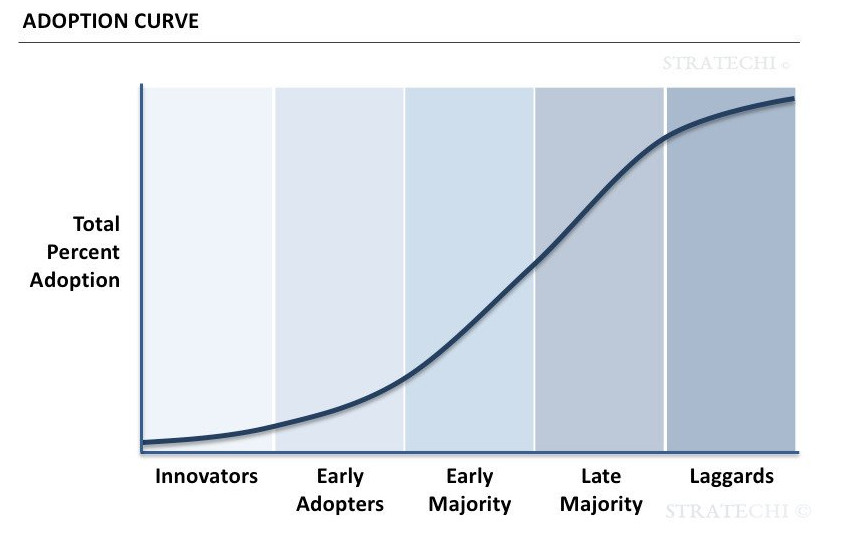
Source: Stratechi.com
How Do Robot LawnMowers Work?
Robot lawnmowers live at a base station (their "home") where they sleep and recharge. When it's time to mow, they navigate your yard on their own and clip the grass a little bit each mow. After they are finished, they return to the home to sleep and recharge. Robot lawnmowers clip less grass each mow, but they mow more frequently.
Cutting your lawn more frequently has benefits because the clippings are small and can return to the soil to provide natural nourishment. Think of it this way - instead of getting a haircut once a month, you go once per week.

Source: Worx.com
Each mower uses an electric battery for its power source - this means it's very clean and quiet (they are typically 55dB to 60dB range). The area that your robot mower can cut depends on the size and type of battery. Large lawns may require multiple charges to mow the entire area. The mower will cut some, go home to recharge on its own, then return to cutting. Most models today have the battery capacity to support 60 to 120 minutes, although some are rated for up to 250+ minutes.
Robot lawnmowers do not have bags to collect clippings since they cut small amounts each mow. This is helpful during most seasons, but you may need to find alternatives to collect leaves during the fall.
Most manufacturers offer a mobile app to control and monitor the mower's progress. You can also schedule when you want it to mow. Also, many models feature onboard sensors to check the weather and determine if the weather conditions are right for mowing (for instance, not mowing during rain and frost).
Most robot lawnmowers navigate in a seemingly random path (similar to robot vacuums) - so you will not have the typical fresh cut "rows" that you get from a normal lawn mower. Robot lawnmowers are lightweight, so they do not leave much of a noticeable pattern at all.
Most robot lawnmowers use a boundary wire to notify it of where it can and cannot mow. The concept is very similar to an electric dog fence - a sensor can tell when it is near the wire by the frequency the wire emits. The boundary wire can be laid above ground with stakes or staples or buried in the ground 1-4 inches. Many experts recommend leaving the wire above ground when you first buy your mower, then burying it after you have "perfected" the mowing path. It takes about 1-2 hours to set up for an average-size lawn.
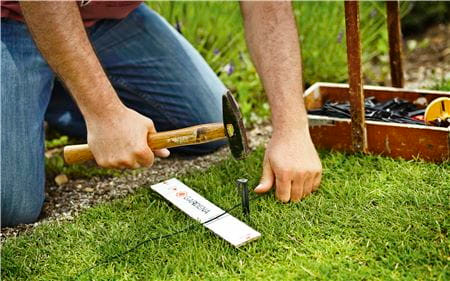
Source: Gardena.com
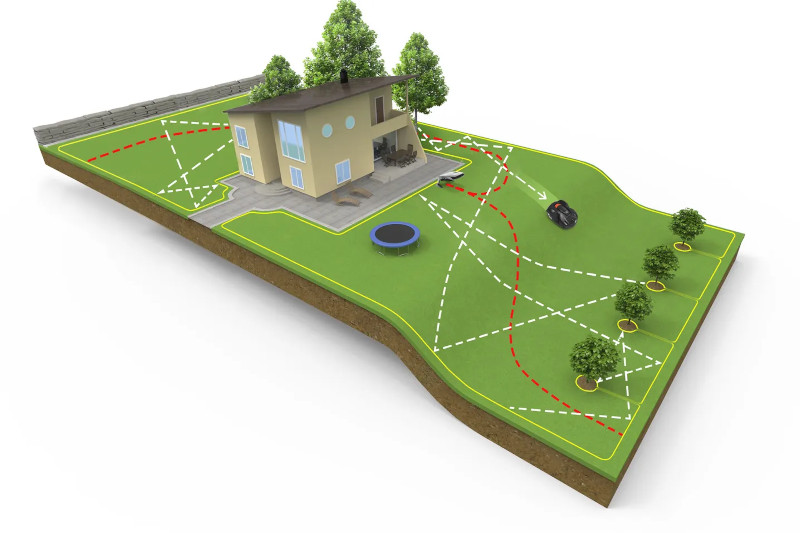
Source: Husqvarna.com
Similar to your car and other smart electronics, robot lawnmowers have onboard sensors that enable the mower to understand its environment. Sensors can include:
- Ultrasound to sense nearby objects (similar to how bats use ultrasound to fly in the dark).
- Humidity/rain/temperature sensors to detect weather conditions.
- "Bump" detection to understand if the mower has hit an obstacle. Typically the blade will stop when this occurs.

Source: Worx.com. Worx Landroid WR155 with Anti-Collision System Attachment (the "eyes")
Most robot mowers can operate on inclines up to 20 degrees, and some can handle much steeper inclines.
You can adjust the cutting height using a dial on the robot mower. Heights vary based on make and model, and some apps enable you to adjust the height electronically. Typically the height is 1 to 3", with some models going up to 4".
How Much Do Robot LawnMowers Cost?
Robot lawnmowers start around $1,000 for entry-level models and go up to to $4,000 for commercial and professional models. Note that some manufacturers, such as Worx, tend to sell accessories separately, so your all-in cost might end up being more than the MSRP. You should bundle all of the accessories you need and calculate the all-in price to compare models side-by-side.
Currently, robot lawnmowers are more expensive than the average push mower. They are the same and even cheaper than many riding mowers. Robot lawnmowers are often cheaper to operate medium-term because they do not require gas, fluids, or an operator (think of the time value of money). Also, many robot lawnmowers typically have electric motors, which means they require less service.
Can My Robot Lawn Mower Be Stolen?
Yes, they can be stolen, but many models have GPS installed so you can track the location and report it to the authorities. Many models also include unique "base pairing" which means that the mower will only work with its specific charging base - the thief would need to steal the base as well. Some models have PIN codes that are required to operate the mower.
Robot lawnmowers are very large and weigh between 10 and 40 pounds, so they are noticeable if someone tries to walk away with it.
The primary risk here is that a thief may take your mower and not know about the security features. They may end up with a mower that does not work and ditch it rather than returning it.
Are Robot LawnMowers Safe?
Every mower has risks associated with it since there are moving parts and sharp blades. That being said, manufacturers have put great thought and time into designing safe mowers. Most robot lawnmowers have controls that will automatically shut off the blade in the event of a collision. Also, most mowers have a button on top of the mower that can be pushed to shut it off in an emergency.
How Long Do Robot LawnMowers Last?
Blades must be replaced after they get dull. The timing will depend on your yard size and the frequency you cut it. Many Husqvarna models have an average blade lifespan for a 1/4 acre lawn of about two months. Blades vary by model. For example, the Worx Landroid system has three blades about 1 inch each (they resemble old-fashioned razor blades).
You should clean your mower at regular intervals with a garden hose and brush (toilet brushes work really well) to remove excess buildup. There is typically very little grass buildup each mow, but it still helps to keep your mower clean.

Source: Gardena.com
Batteries lose their capacity and power rating over time. Each battery is different based on its size and chemical composition. You should read manufacturer specifications to understand your battery life cycle. Most robot lawn mower models are designed for easy swap-in / swap-out of the batter if you need to replace it.
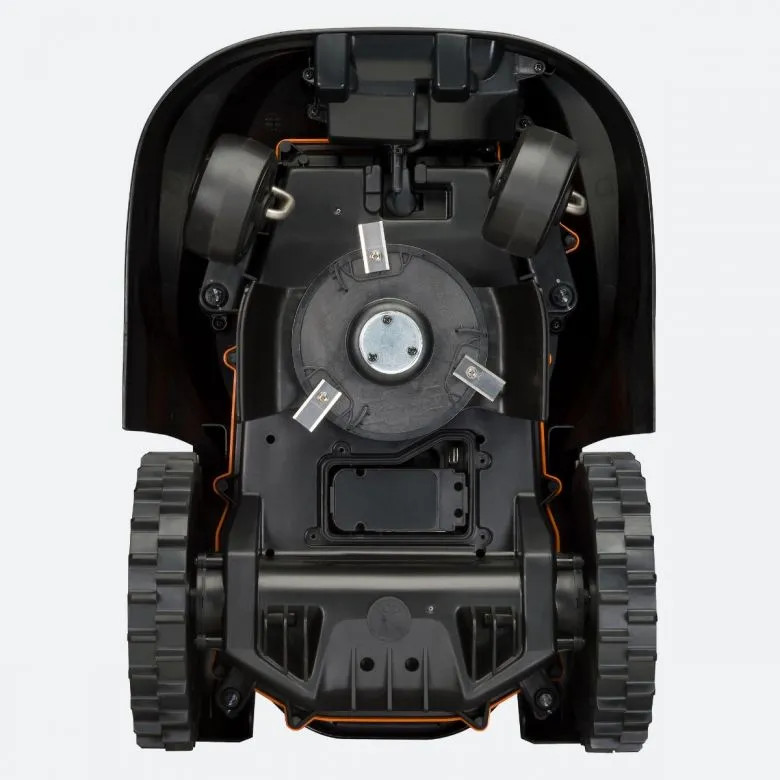
Source: Worx.com. Worx Landroid underbelly with blades visible
What Are The Downsides?
- Some people enjoy the exercise involved with mowing. Your exercise will be reduced to pushing buttons on your smartphone.
- Robot lawnmowers are not meant for collecting leaves. You may need to find alternatives for leaf collection.
- Robot lawnmowers can be more expensive than push mowers.
- Not all models allow easy battery swap in / swap out.
Items You Should Consider
- Price
- How do you like the mobile app (if it has one)? Download it and try it out before buying. You can also watch videos online.
- Does the cutting height range fit your needs? Some models are able to cut higher than others.
- Is the blade size and diameter what you need?
- How much will it cost to replace blades, and how often will you need to replace blades?
- Does the battery have sufficient capacity to cover your lawn?
- Does the mower have security / theft protection (GPS)?
Worx
Worx offers the most inexpensive robot lawn mower models; however, you will have to pay more for adding accessories that are included with other manufacturers. Most consumer reviews have been very positive, given the simple and effective mower design.
Worx's mobile app has over 3,000 reviews with an average rating of 3 stars.
Worx Landroid L WR155
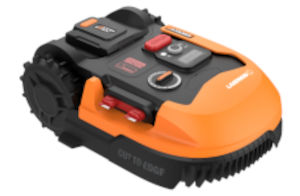
Price: $1,399
Type: Residential Mower
Area: 0.5 acres
Cutting Height: 1.5-3.5 in
Battery Mow Time: 115 min
Worx Landroid M WR147

Price: $1,099
Type: Residential Mower
Area: 0.25 acres
Cutting Height: 1.5-3.5 in
Battery Mow Time: 75 min
Worx Landroid S WR165
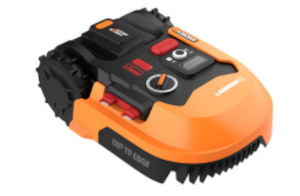
Price: $949
Type: Residential Mower
Area: 0.125 acres
Cutting Height: 2.0-3.5 in
Battery Mow Time: 75 min
Husqvarna
Husqvarna offers the widest selection of robotic lawn mowers, with both residential and commercial models. Husqvarna's mobile app is well designed and useful (more than 10,000 reviews with an average rating of 4.5 stars). Find Husqvarna dealers
Husqvarna Automower 155H
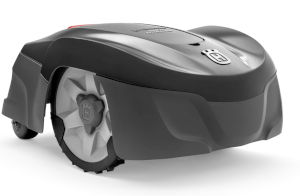
Price: $1,199-1,399
Type: Residential Mower
Area: 0.4 acres
Cutting Height: 2.0-3.6 in
Battery Mow Time: 60 min
Husqvarna Automower 315X
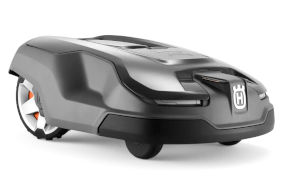
Price: $1,799
Type: Residential Mower
Area: 0.4 acres
Cutting Height: 0.8-2.4 in
Battery Mow Time: 70 min
Husqvarna Automower 430X/430XH
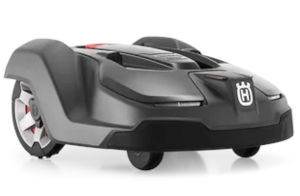
Price: $2,499
Type: Residential Mower
Area: 0.8 acres
430X Cutting Height: 0.8-2.4 in
430XH Cutting Height: 0.8-3.6 in
Battery Mow Time: 145 min
Husqvarna Automower 450X/450XH
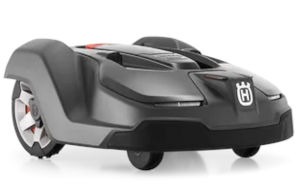
Price: $4,099
Type: Residential Mower
Area: 1.25 acres
450X Cutting Height: 0.8-2.4 in
450XH Cutting Height: 0.8-3.5 in
Battery Mow Time: 270 min
Husqvarna Automower 520/520H
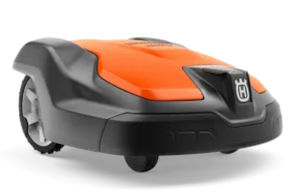
Type: Commercial Mower
Area: 0.6 acres
520 Cutting Height: 0.8-2.4 in
520H Cutting Height: 0.8-3.6 in
Battery Mow Time: 75 min
Husqvarna Automower 550/550H
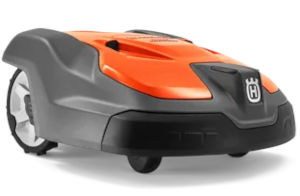
Type: Commercial Mower
Area: 1.25 acres
550 Cutting Height: 0.8-2.4 in
550H Cutting Height: 0.8-3.5 in
Battery Mow Time: 270 min
Husqvarna Automower 550 EPOS/550H EPOS
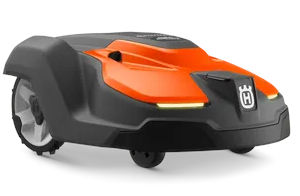
Type: Commercial Mower
Area: 1.25 acres
550 EPOS Cutting Height: 0.8-2.4 in
550H EPOS Cutting Height: 0.8-3.6 in
Battery Mow Time: 200-210 min
Husqvarna Automower 535 AWD
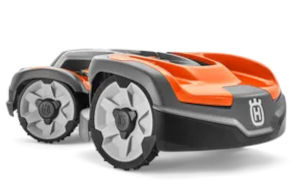
Type: Commercial Mower
Area: 0.9 acres
Cutting Height: 1.2-2.8 in
Battery Mow Time: 100 min
Gardena
Gardena is based in Europe and has a smaller product offering than Worx and Husqvarna. Also, the cutting area is much smaller than others.
Gadena SILENO minimo
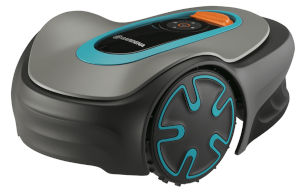
Type: Residential Mower
Area: 0.12 acres
Cutting Height: 0.8 -1.8 in
Battery Mow Time: 70 min
Gadena SILENO city
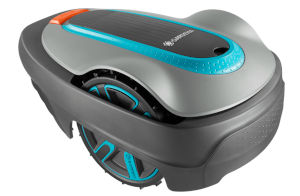
Type: Residential Mower
Area: 0.06 acres
Cutting Height: 0.8 -2.0 in
Battery Mow Time: 65 min
John Deere
John Deere currently has one robot lawn mower called the Tango E5. John Deere is a leader in agriculture and lawn care - it carries a full suite of riding lawn mowers such as the S100 Series Lawn Tractor, so it is likely that it will continue expanding its robotic models in the future. The Tango E5 currently does not have a mobile app. Find John Deere dealers
John Deere Tango E5
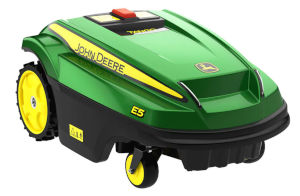
Price: $1,999
Type: Residential Mower
Area: 0.5 acres
Cutting Height: 0.7-4.0 in
Battery Mow Time: 90 min
Honda Miimo
Honda is a leader in lawn care and robotics, so it is likely that it will continue expanding its robotic lawn mower line in the future. Currently, it has one model, the miimo. Find Honda dealers
Honda miimo HRM310 / HRM520
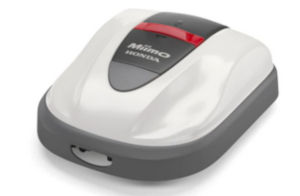
Type: Residential Mower
Area: 0.75 acres
Cutting Height: 0.8-2.4 in
Battery Mow Time: 30-60 min



